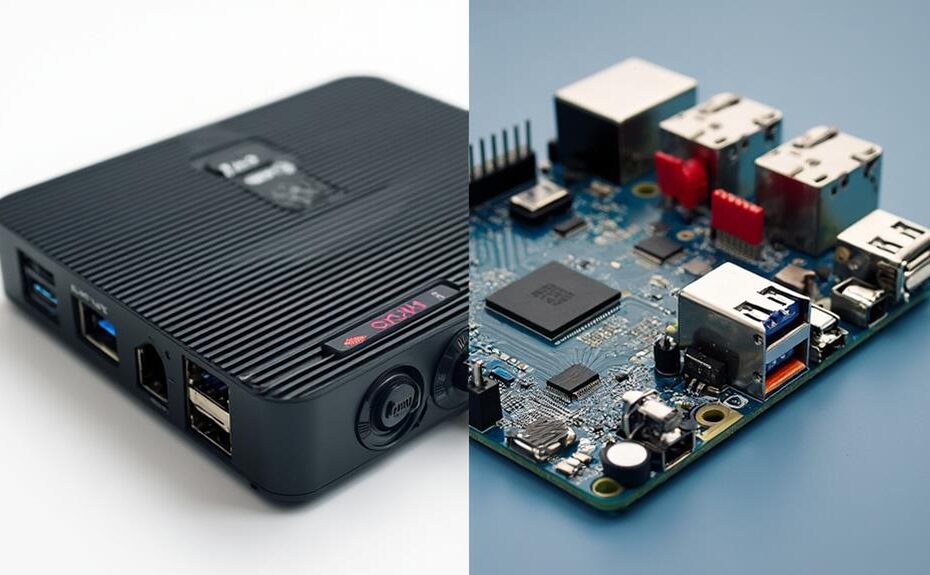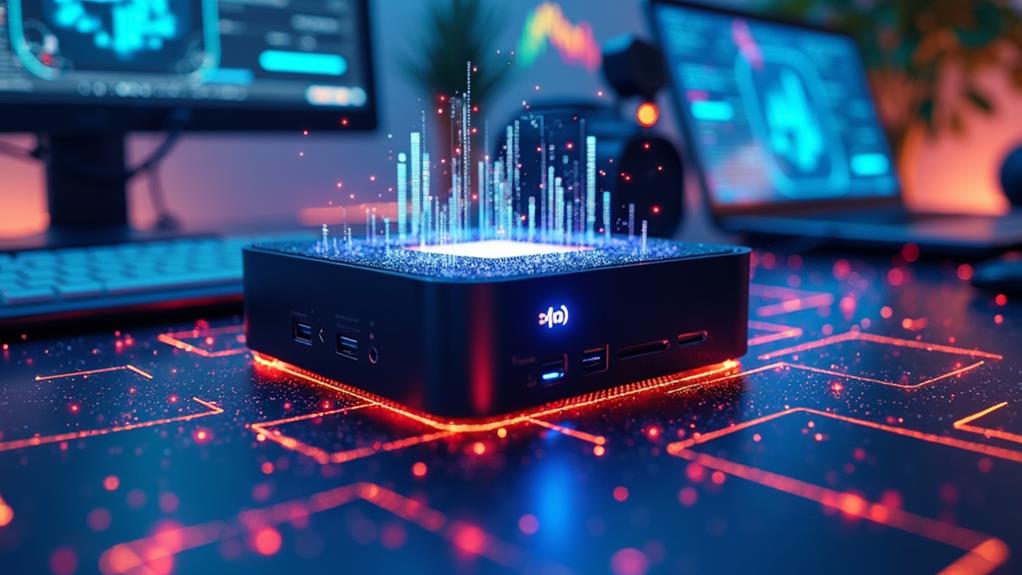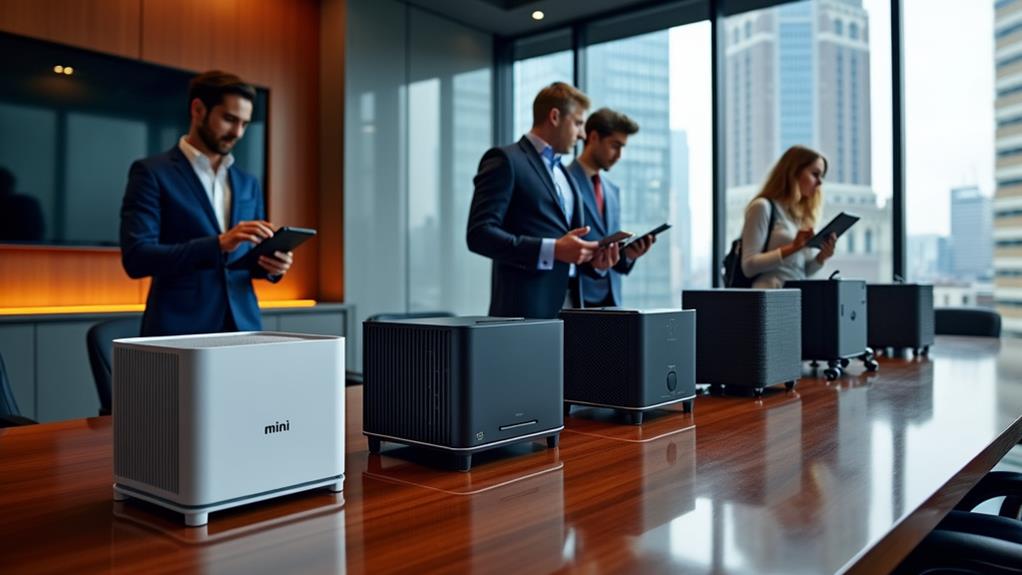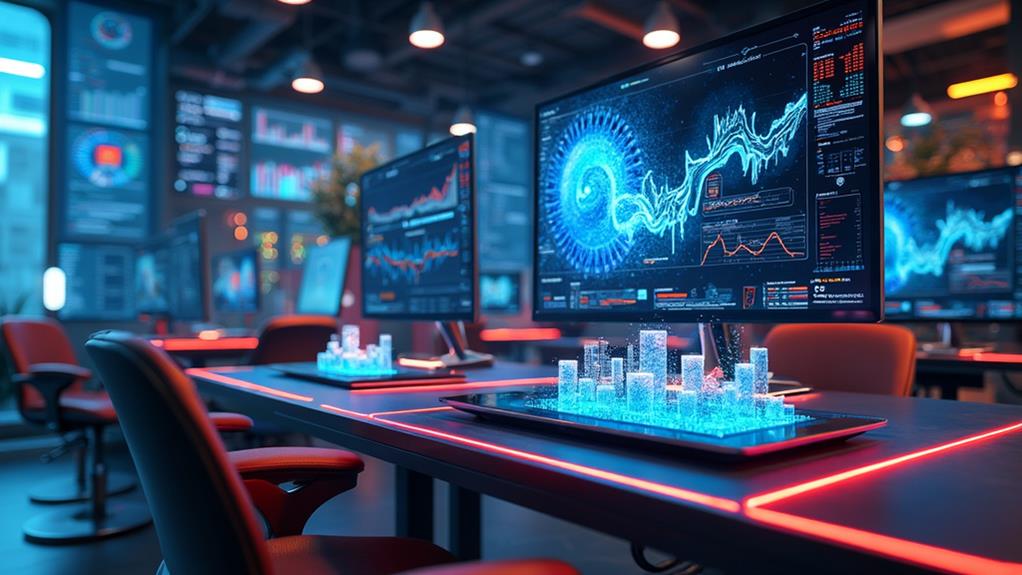



Mini PCs and Single-Board Computers (SBCs) differ mainly in design and functionality. Mini PCs are compact desktop computers with powerful processors and can run full operating systems like Windows or Linux, making them great for demanding tasks. They're versatile and ideal for media consumption or office work. On the other hand, SBCs, like Raspberry Pi, feature all components on a single circuit board and focus on specific tasks, often requiring additional peripherals. They're budget-friendly and excel in IoT projects and embedded systems. Understanding these distinctions can help you choose the right device for your needs.
Key Takeaways
- Mini PCs offer powerful performance and run standard operating systems, while SBCs are designed for specific tasks with low power consumption.
- Mini PCs support upgrade options for RAM and storage, whereas SBCs typically have limited upgradability due to their all-in-one design.
- Mini PCs are suitable for general computing and media consumption; SBCs excel in embedded applications, IoT, and robotics.
- Mini PCs generally cost around $300, while SBCs are more budget-friendly, ranging from $5 to $200.
- Mini PCs consume more energy than SBCs, which are optimized for energy efficiency and portable applications.
Definition of Mini PCs
Mini PCs serve as compact desktop computers that pack a punch without taking up much space. Designed for efficient computing, mini PCs feature full-fledged desktop processors and can easily handle various tasks. Whether you're working on productivity software or streaming media, these devices support standard operating systems like Windows and Linux, making them versatile for different user needs. Additionally, their ruggedness and energy efficiency make them suitable for industrial applications, where operational effectiveness is essential.
One of the standout benefits of mini PCs is their multiple connectivity options. With USB ports, HDMI outputs, and Ethernet connections, you can seamlessly integrate these computers with various peripherals and networks, enhancing their functionality. This flexibility makes them ideal for both home and office environments.
Affordability is another appealing factor; the average price of mini PCs hovers around $300, making them a smart choice for budget-conscious consumers. Plus, their lower power consumption compared to traditional desktops not only saves money but also promotes energy efficiency.
Definition of Single-Board Computers
Single-board computers (SBCs) are compact, efficient devices that integrate all essential components onto a single circuit board, making them a popular choice for various applications. Each Single Board Computer typically includes a CPU, RAM, and I/O interfaces, resembling a standard ISA/PCI card. Their small size—often credit card or palm-sized—means they fit perfectly in space-constrained environments like IoT devices and robotics.
Designed for low power consumption, SBCs are well-suited for embedded systems, educational projects, and prototyping, all while remaining budget-friendly. Unlike Mini PCs, which can run full desktop operating systems, SBCs usually require additional peripherals to function and are less powerful, focusing instead on specific tasks. This makes them ideal for users who need an affordable, specialized solution for projects rather than a full-fledged computing experience.
Popular examples of Single Board Computers include the Raspberry Pi, Arduino, and LattePanda. Each caters to a variety of applications, ranging from educational settings to industrial uses. If you're considering a project that requires efficient, compact computing, an SBC might be the perfect fit for your needs.
Key Features of Mini PCs
Compact desktop computers have become increasingly popular due to their ability to deliver powerful performance in a small form factor. Mini PCs are designed to run standard operating systems like Windows or Linux, showcasing full-fledged desktop processors that handle a variety of tasks with ease. They typically offer upgrade options, housing 1-2 NVME drives and 2x SO-DIMMs for RAM, which can be tailored to meet specific performance needs as your requirements evolve. This flexibility allows you to enhance performance as your needs grow.
One of the standout features of Mini PCs is their energy efficiency; they consume less power than traditional desktops. This makes them ideal for office work, media consumption, and other applications where energy costs matter. With multiple USB ports, HDMI, and Ethernet connectivity, Mini PCs provide greater I/O options than single-board computers, accommodating a wider range of peripherals and devices.
Additionally, priced around $300, Mini PCs appeal to budget-conscious consumers seeking compact and efficient computing solutions. Whether you need a home theater setup or a workstation, Mini PCs combine performance, versatility, and energy efficiency into a single, space-saving unit, making them a smart choice for modern users.
Key Features of SBCs
When it comes to innovative computing solutions, single-board computers (SBCs) stand out for their all-in-one design that integrates essential components like the CPU, RAM, and I/O interfaces onto a single circuit board. This compact design not only optimizes space efficiency but also makes SBCs ideal for portable applications. Typically, they're smaller than traditional motherboards, often resembling the size of a credit card or palm, prioritizing low power consumption, which is vital for applications in IoT and robotics. Mini PCs in retail showcase how compact systems can be both powerful and efficient, providing insights into their application in various environments.
Many popular SBCs, such as the Raspberry Pi, are specifically designed for educational purposes and hobbyist projects, making them cost-effective, with prices ranging from $5 to $200. Their rich I/O capabilities allow seamless interaction with various physical devices, enhancing their versatility for embedded systems and prototyping.
Unlike conventional motherboards that support a wide range of peripherals and high-end processing capabilities, SBCs are tailored for specific tasks, which can limit their upgradability and performance compared to more complex systems. This specialization, however, makes them perfect for dedicated applications where low power and compactness are necessary.
Pros and Cons Comparison
While both Mini PCs and SBCs offer unique advantages, understanding their pros and cons can help you choose the right fit for your needs. Mini PCs typically boast powerful processors and support for larger RAM capacities, making them ideal for demanding applications like gaming or video editing. They run standard operating systems, providing an experience similar to traditional desktops. However, they tend to have higher power consumption and are generally more expensive, averaging around $300.
On the other hand, SBCs are budget-friendly, often costing between $5 and $200, which makes them appealing for projects with limited budgets. They excel in I/O capabilities, allowing extensive interaction with physical devices, which is great for sensor integration in DIY projects. However, they usually max out around 8GB of RAM and may require you to adapt to lighter operating systems. Their compact, credit card-sized form factor offers excellent portability, but they aren't as versatile for tasks like media playback.
Applications for Mini PCs
Mini PCs find applications across a broad spectrum of environments, making them versatile tools for both personal and professional use. You'll find them perfect for office work, where they provide a full Windows or Linux OS experience comparable to traditional desktops. If you enjoy media consumption or light gaming, a mini PC can deliver the performance you need without taking up much space.
In the domain of digital signage, mini PCs excel by running content management systems and supporting various screen sizes and resolutions. This makes them ideal for dynamic displays in retail or corporate settings. Their compact design also makes them appealing for home theaters or as dedicated gaming machines, delivering high performance in a small form factor.
With multiple USB ports, HDMI, and Ethernet connectivity, the applications for mini PCs extend to enhancing productivity and connectivity in both home and office environments. Whether you're looking for a space-saving solution or robust performance, mini PCs offer an efficient computing experience tailored to your needs. Their versatility guarantees they can adapt to various tasks, making them a smart choice for anyone seeking a reliable computing solution.
Applications for SBCs
Single-board computers (SBCs) are revolutionizing the way we approach technology in various fields. Their compact design and low power consumption make them ideal for embedded applications, particularly in IoT devices, robotics, and industrial automation. You'll find SBCs like the Raspberry Pi thriving in educational settings, where over 40 million units sold highlight their role in hands-on learning for programming and electronics.
One of the biggest advantages of SBCs is their ability to enable rapid prototyping and development. With rich I/O capabilities and compatibility with numerous sensors and peripherals, you can easily create diverse projects tailored to your needs. In commercial and industrial environments, SBCs are instrumental in tasks such as data acquisition, monitoring systems, and automation controls, thanks to their reliability and affordability.
As the demand for IoT solutions continues to grow, the applications for SBCs are becoming increasingly relevant. The market for these devices is projected to expand at a CAGR of 10% from 2023 to 2028, underscoring their significance in modern technology applications. Whether you're a hobbyist, educator, or industry professional, SBCs offer endless possibilities for innovation.
Choosing the Right Option
When selecting between a Mini PC and an SBC, it is important to align your choice with the specific needs of your project. If you're looking for more processing power and the ability to run full desktop operating systems like Windows or Linux, a Mini PC is the way to go. It's ideal for demanding applications, general desktop use, and media consumption. On the other hand, if you need a cost-effective solution for lower power tasks, an SBC is a better fit, especially for budget-sensitive projects.
When choosing the right option, consider the connectivity requirements. Mini PCs usually offer multiple USB ports and HDMI outputs, while SBCs excel in I/O capabilities for interacting with physical devices, making them perfect for embedded applications. Additionally, think about power consumption; Mini PCs are designed for low usage but typically consume more energy than SBCs, which are optimized for efficiency and suited for continuous operation.
Ultimately, your choice should reflect the intended application. For specialized tasks like IoT and robotics, SBCs shine, while Mini PCs serve well for general computing and media tasks.
Disclosure: As an Amazon Associate, I earn from qualifying purchases.






